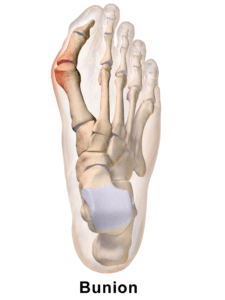Diabetes, or hyperglycemia, is abnormally high blood glucose. If blood sugar levels are not normalized in a diabetic, the body may have trouble fending off infections due to decreased functioning of the immune system. This can affect the feet in particular due to peripheral artery disease (lack of circulation) and peripheral neuropathy (loss of feeling).
As a result of diabetes, the feet may become susceptible to a host of problems, such as ulcers and wounds that do not heal properly, fungal infections, ingrown or brittle toenails, corns, calluses, hammertoes, athlete’s foot, and cracked or dry skin. Gangrene, or dead tissue, can develop, causing bacterial infections that may result in amputation of the affected areas. Everyday activities such as walking can cause issues in the feet of a diabetic, as the bones, joints, and skin are affected by the condition.
For the diabetic, proper and thorough foot care is imperative. Diabetics should check their feet daily for early detection of foot problems or injuries and follow up with a podiatric physician on a routine basis.
To avoid serious foot problems that could result in losing a toe, foot or leg, follow these guidelines.
Inspect your feet daily: Check for cuts, blisters, redness, swelling or nail problems. Use a magnifying hand mirror to look at the bottom of your feet. Call your doctor if you see anything abnormal.
Bathe feet in lukewarm, never hot, water: Use only lukewarm water—the temperature you would use on a newborn baby.
Moisturize your feet but not between your toes: Use a moisturizer daily to keep dry skin from itching or cracking. But don’t moisturize between the toes, it could lead to a fungal infection.
Cut nails carefully: Cut them straight across and file the edges. Don’t cut nails too short, as this could lead to ingrown toenails.
Never treat corns or calluses yourself. No “bathroom surgery” or medicated pads. Visit your doctor for appropriate treatment.
Consider socks made specifically for patients living with diabetes: These socks have extra cushioning, do not have elastic tops, and are made from fibers that wick moisture away from the skin.
Wear clean, dry socks: Change them daily.
Shake out your shoes and feel the inside before wearing: Your feet may not be able to feel a pebble or other foreign object, so always inspect your shoes before putting them on.
Never walk barefoot: Not even at home! Always wear shoes or slippers. You could step on something and get a scratch or cut.
Take care of your diabetes: Keep your blood sugar levels under control. Consider adopting a low carbohydrate diet.
Do not smoke. Smoking restricts blood flow in your feet.
Get periodic foot exams. Seeing your podiatric physician on a regular basis can help prevent the foot complications of diabetes.



